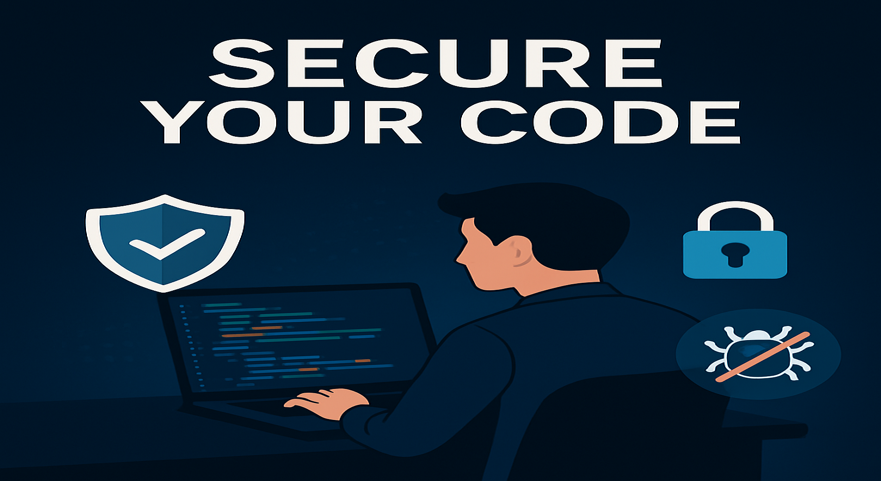Cybersecurity for Developers: Building Secure Code

🔐 Why Cybersecurity for Developers Matters
As threats to digital infrastructure increase, cybersecurity for developers has become a mission-critical responsibility. Security is not just a concern for IT professionals — developers must now build software with security baked into every line of code. Secure development prevents data leaks, ransomware infections, and application breaches that could affect millions of users.
🔧 Core Principles of Cybersecurity for Developers
1️⃣ Input Validation and Sanitization
Many cyber-attacks exploit poor input validation. Developers must ensure that all external data is strictly validated and sanitized to prevent injection flaws.
- Use regular expressions to enforce correct formats.
- Escape special characters to prevent SQL injection and XSS.
- Never trust user input — always validate on both client and server sides.
2️⃣ Output Encoding
Avoid rendering dynamic content directly into HTML or scripts.
- Apply context-aware output encoding (HTML, JavaScript, URL).
- Prevent browsers from interpreting output as executable code.
- This is a vital measure for cybersecurity for developers working on frontend-heavy applications.
3️⃣ Authentication and Authorization
Insecure login flows are frequent targets for hackers.
- Enforce Multi-Factor Authentication (MFA).
- Hash passwords using secure algorithms like Argon2 or Bcrypt.
- Use Role-Based Access Control (RBAC) to restrict sensitive functions.
🔐 Importance of Encryption
- Use TLS (HTTPS) to protect data in transit.
- Encrypt sensitive fields (e.g., personal data, payment info) with AES-256.
- Never log plaintext credentials or sensitive tokens.
This is a cornerstone of cybersecurity for developers, especially those building financial or healthcare applications.
🔁 Integrating Security in the SDLC
Secure Software Development Lifecycle (SSDLC)
Cybersecurity for developers means integrating security from start to finish:
Phase | Security Activities |
Requirements | Identify security risks and compliance needs |
Design | Conduct threat modeling (e.g., STRIDE) |
Development | Apply secure coding standards (OWASP Top 10) |
Testing | Use SAST, DAST, and penetration testing |
Deployment | Harden configurations and monitor continuously |
Maintenance | Regular updates, patching, and log analysis |
🛠️ Developer Tools for Security
To enhance cybersecurity for developers, use automated tools:
- Code Scanning: SonarQube, Semgrep
- Dependency Auditing: OWASP Dependency-Check, Snyk
- Secrets Detection: GitGuardian, TruffleHog
- Container Security: Docker Bench, Anchore
🛡️ Common Vulnerabilities Developers Must Avoid
- SQL Injection
- Cross-site Scripting (XSS)
- Cross-Site Request Forgery (CSRF)
- Hardcoded credentials
- Insecure Deserialization
- Use of deprecated crypto libraries
Understanding and avoiding these issues is a core duty under cybersecurity for developers.
✅ Developer’s Secure Coding Checklist
- 🔒 Validate and sanitize inputs
- 🔒 Encode outputs
- 🔒 Use HTTPS and modern encryption
- 🔒 Store secrets securely (no hardcoding)
- 🔒 Apply least privilege principle
- 🔒 Scan and patch dependencies regularly
- 🔒 Review and test code for vulnerabilities
Following this checklist helps fulfill the objectives of cybersecurity for developers at every level of the stack.
🔍 Logging, Monitoring & Incident Response
Cybersecurity for developers also includes preparing for threats that bypass defenses.
- Configure structured logging with alert systems.
- Detect anomalies (e.g., failed logins, unauthorized access).
- Design recovery procedures and escalation plans.
🏢 Enterprise Relevance: Real-World Examples
Many large breaches (e.g., Equifax, SolarWinds, Capital One) occurred due to insecure development practices. With increasing regulatory scrutiny (GDPR, HIPAA, PCI-DSS), cybersecurity for developers has become mandatory in enterprise environments.
📢 Partner with Experts
If your team is working on enterprise or cloud-native applications, Tech i-vin Technology offers specialized solutions for secure software development. We help organizations embed cybersecurity for developers through code audits, training, and implementation of DevSecOps frameworks.
